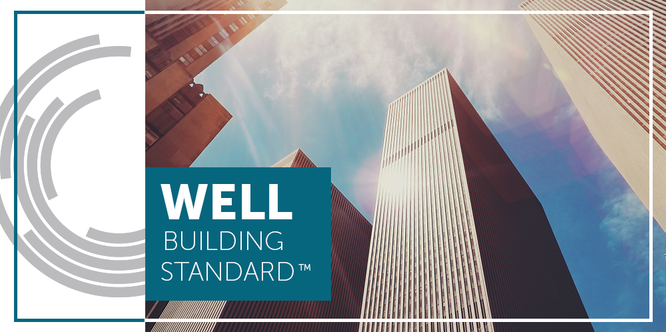The built environment can have a profound impact on people’s health, wellbeing and productivity. Michael Davey of McCann & Partners takes a look at the WELL Building Standard, which aims to optimise design and operations to create healthier, happier workplaces
The WELL Building Standard is revolutionising the way employers think about buildings. It explores how design, operations and behaviours within the places we live, work, learn and play can impact our health and wellbeing and shows us ways to best optimise those factors for a cleaner, healthier workplace.
The WELL Building Standard is managed and administered by the International WELL Building Institute (IBWI), who are a public benefit corporation whose mission is to improve human health and wellbeing through the built environment.
On average, we spend 90% of our time indoors so being in a building can have a profound impact on our health, happiness and productivity. It can also have a lasting impact on our bodies, mind and how we sleep. The WELL Building Standard presents a performance-based system for certifying features of the built environment that impact health and wellbeing. It codifies best practice and shows that it is possible to integrate human sustainability in architectural design by creating spaces and buildings that make you healthier.
There are many benefits to having the WELL Building Standard: a WELL-certified office can help attract and retain employees, clients and investors, maximise performance of employees by contributing to increased productivity, reduced absences and increased job satisfaction/engagement, as well as promote good health and wellbeing to 100% of employees.
WELL-compliant buildings can help create a built environment that improves nutrition, fitness, mood and sleep patterns. It works so well in Asia that employees spend most of their time in the workplace due to significantly better air and water quality than at home.
Key factors of a WELL building come down to influences such as good quality air and the right amount of natural light; however, WELL delves much further than this. WELL buildings also take into account the ways the building can help tackle obesity and reduce stress. Other contributing factors also include the air filtration systems and window design as well as offering healthy food, opportunities for breaks between meetings or educational programmes for workers.
As the first standard of its kind to focus solely on human health and wellness, it covers seven core concepts of health – air, water, nourishment, light, fitness, comfort and mind – with each category divided into a number of features.
Let’s look at these in closer detail:
Air: Air quality has a significant impact on occupational health. Polluted air can cause certain respiratory issues and also trigger asthma and allergies. The WELL standard helps improve air and minimise indoor pollution, as well as providing managers with advice on cleaning protocol and air filtering systems.
Water: WELL certification requires the availability and quality of water for all employees. Clean, filtered water should be available in every water cooler and dispenser, which is required within 100 ft of every occupied desk, for example.
Nourishment: This aspect of WELL Building Standard limits highly processed foods, and supports mindful eating and the availability of wholesome, fresh foods. It also includes the availability of nutritional information as well as measuring performance based on healthy eating habits and the availability of fresh foods. It looks too at the correct storage of food, contamination and safe food preparation.
Light: One of the major causes of headaches and eyestrain is lighting levels, which can be avoided with proper lighting. Low lighting or artificial lighting can strain eyes and increase the risk of general visual discomfort. WELL provides illumination guidelines to assist organisations in ensuring their building lighting is optimised to enhance the health and wellbeing of occupants.
Fitness: Research shows that on average, employees spend almost six hours a day sitting at their desk. This sort of sedentary lifestyle can lead to health problems such as diabetes, heart attacks and increased risk of obesity. The WELL Building Standard helps address these risks by promoting movement and fitness through design, by encouraging the adoption of furniture that offers mobility and promoting the more use of stairs.
Comfort: If your employees aren’t comfortable at work, their productivity will be affected. A comfortable working environment requires accessibility to amenities, ergonomic furniture, appropriate noise levels and temperature. The WELL Building Standard aims to create a comfortable environment where employees can feel at ease and work more productively.
Mind: Mental and physical health are closely linked. Poor health often leads to poor mental wellbeing. The indoor environment can affect mental wellness and should be developed to reduce stress levels, improve moods and promote overall health and wellness. WELL supports mental health and wellbeing by encouraging building design policies that are designed to minimise stress and support employees.
The ‘features’ contained within the above concepts are used to protect and lessen the negative effects of the built environment on 11 of the body’s systems – cardiovascular, digestive, endocrine, immune, integumentary, muscular, nervous, reproductive, respiratory, skeletal and urinary.
The WELL Building Standard is currently being used in 51 countries with 185 certified schemes and with these health and wellbeing incentives it’s not hard to see why. There are accredited professionals in 82 countries and 8,431 people in the WELL community around the world, with only 203 of those in the UK. It’s a continually evolving programme and, as such, pilot schemes are in development to test and refine how WELL can best apply to different space types, including residential, retail, education, restaurants and commercial kitchens.
When you see the many benefits to working in a WELL building, the link between productivity and good health is clear. Employees will have improved wellbeing, enhanced productivity and lower absenteeism, as well as having their mood boosted, which leads to a higher duty of responsibility, care and eagerness to learn and work hard. Having a WELL building means employers have the opportunity to make their offices positive, healthy, productive workspaces.
Michael Davey
Associate Director
Tel: +44 (0)29 2035 2450
Twitter: mccannmep
LinkedIn: mccann-and-partners














